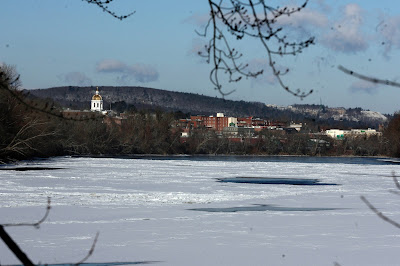Painting the panel for a handcrafted “Trumeau” style mirror for the Friends Program auction.
When Bob Larsen asked me to
participate, I immediately thought of a photo that Ken Williams had
taken of the Merrimack, with the capitol building in the background.
I really love rivers and wanted to paint the Merrimack. Terrill park
is a really under-used treasure in the Concord park system and the
view of the city from there hides the ugly highway.
It was a cold, cold, windy day when I
ventured out to Terrill Park on my lunch hour. There was a family
there, waiting in the car while the mother ran the dog in the dog
park. There was open water reflecting the cloudless blue sky and icy
patches with snow on the river. The wind off the water made my eyes
water. The city, with the capitol towering to the left, was mostly
obscured by the trees along the far shore and seemed distant and
bright. I searched around to find the spot that retired Monitor photographer Ken Williams shot
that long-ago photo I remembered. I even ventured north along the
wooded swampy (but frozen) shore where signs forbid trespassing. It
seemed unlikely that the police would notice my infringement and I
ventured out to the edge of the bank, stumbling near the water and
abusing my knee. The view was not significantly better so I abandoned
my lawlessness and returned to the park.
Though there was the barest reflection of the dome, I liked the pattern on the water and
the glow from the capitol on the ice and snow. The
hills were darkish at mid-day and I wondered how it would look on a
sunny bright morning. I have a little point-and-shoot camera which didn't bring out much detail in the city beyond the
scrub. And I remember the trees looking warmer than the photo came out. I soaked in the view until my toes and fingers were numb and I
took refuge in the car.
I worked out a sketch from the photo
while it was still fresh in my mind and decided that I'd rather have
more water than sky, concentrating on the river more than the
buildings. Still, it was difficult to make out the particularities of
the structures. I asked my friend Alex Cohn, photo editor at the paper, to take a photo from the
same spot with his telephoto lens. That helped with buildings. Even
if I'm not painting details, I felt like I needed to see them clearly to
understand what I was going to paint.
 |
| Alex Cohn’s great shot of the city from the same spot. |
I glued Claussen's #13 to the panel. I
was glad that they allowed me to work on a surface I was comfortable
with. I got the call to participate just before my vacation and found
myself chomping at the bit in Florida, wishing I could get started on
the painting. Since I had my laptop with me, I decided to study the
buildings from Alex's photo, by drawing them as a graphic with
Illustrator, which became the image used for the promotions and
tickets. It enabled me to understand more of what I was going to
paint.
 |
| The graphic I made while in Florida. |
I followed my sketch and the photo I
took on site for the shoreline and water, and used Alex's photo for
my guide to the buildings and hills. By the time he had taken his
photo, the river had frozen almost completely and was covered with
snow. The under painting went better than I'd hoped. Curiously, the
parts I labored on the most looked weak at best and the parts I
barely thought about and only quickly sketched out in paint were the
most captivating. One of God's mysteries for sure.
 |
| Drying the painting in my make-shift kitchen studio. |
This is the list of what I came up with
in the following days to eliminate the distractions:
- Shoreline – redo the line of the far embankment, with more water to the right and bringing the snowy area more the the foreground, slightly lower with water between that and the shore.
- Darken the value in the large upper water area and dull it to reflect the shoreline slightly.
- More value changes in the water areas.
- Extend the point of the right shore and lean branches over the water more, lightening values to be more in line with the lighting.
- Vary the values in the buildings, show more shadows.
- Work on the capitol, too skinny and looks like it's leaning.
- Darken the snow so that the highlights are more prominent.
- Reflect the dome subtly as possibly, as a glow on the icy patches.
- Consider redoing the sky
- Repaint in the hanging branch that I missed in the first go-round but that is prominent in the sketch.
- Work on the right shoreline.
 |
| The finished painting. |
I had a good time of playing with the
depth of the icy patches and reflections of the sky in the deeper
open water. I do love to paint rivers. But repainting the sky would
mean extra time to dry, which fortunately, I was able to manage. The
resulting sky isn't greatly different than the first one but it glows
more and I'm much happier with it.
The Friends Program is a non-profit organization and the auction is one of the ways they fund the great work they do. I love that my work has been included and that I am in such a great company of artists. Check out the submissions at http://www.friendsprogram.org/events/auction-items. And if you're in the Concord area, the paintings and mirrors will be on display April 19 during Concord's Art Walk, and of course at the auction, May 3.


















